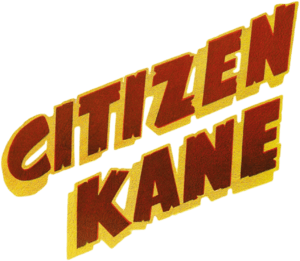Citizen Kane facts for kids
Quick facts for kids Citizen Kane |
|
|---|---|

Original 1941 logo
|
|
| Directed by | Orson Welles |
| Produced by | Orson Welles Richard Baer (associate - uncredited) |
| Written by | Orson Welles Herman J. Mankiewicz |
| Studio | Mercury Productions RKO Radio Pictures |
| Distributed by | Metro-Goldwyn-Mayer (theatrical) Paramount Pictures (1991 re-release) Warner Bros. (DVD) |
| Running time | 119 |
| Country | United States |
| Language | English |
| Budget | $686,033 (estimated) |
Citizen Kane is a 1941 American drama movie, starring Orson Welles in his first full-length movie. There are rumours that the story of the movie is based on the life of famous businessmen William Randolph Hearst, Howard Hughes and Samuel Insull. Welles said that his character, Kane, is based on more than one famous person. In 1974's F for Fake, he said that Kane was going to be based on Hughes, but he was later inspired by Hearst.
For this movie Orson Welles worked closely with his cinematographer Gregg Toland. The cinematographer is the person in charge of the camera and the lights. Together, they worked on a new style called "deep focus." Usually, if something close to the camera is in focus, something that is far away is out of focus. In the deep focus style, every object is in focus at the same time.
Its working title (the name of a movie used before it is finished) was RKO 281.
Many have called Citizen Kane the best movie of all time. In 1998, it was number one on the American Film Institute's list of 100 Years... 100 Movies.
The movie in some ways is like 1933's The Power and the Glory.
The last living crew member was director Robert Wise (also known for making 1965's The Sound of Music). He died on September 14, 2005.
Images for kids
-
Welles's 1938 radio broadcast of "The War of the Worlds" caught the attention of RKO
-
Cinematographer Gregg Toland wanted to work with Welles for the opportunity of trying experimental camera techniques that other films did not allow.
See also
 In Spanish: Citizen Kane para niños
In Spanish: Citizen Kane para niños










